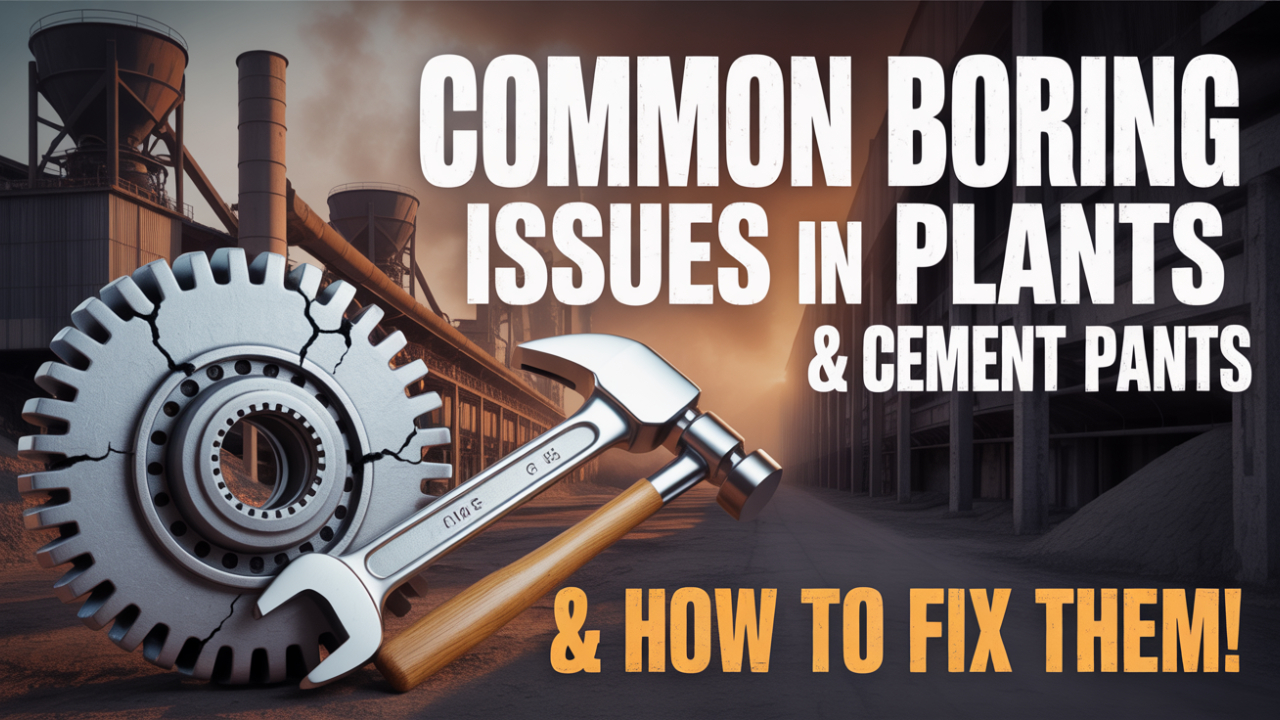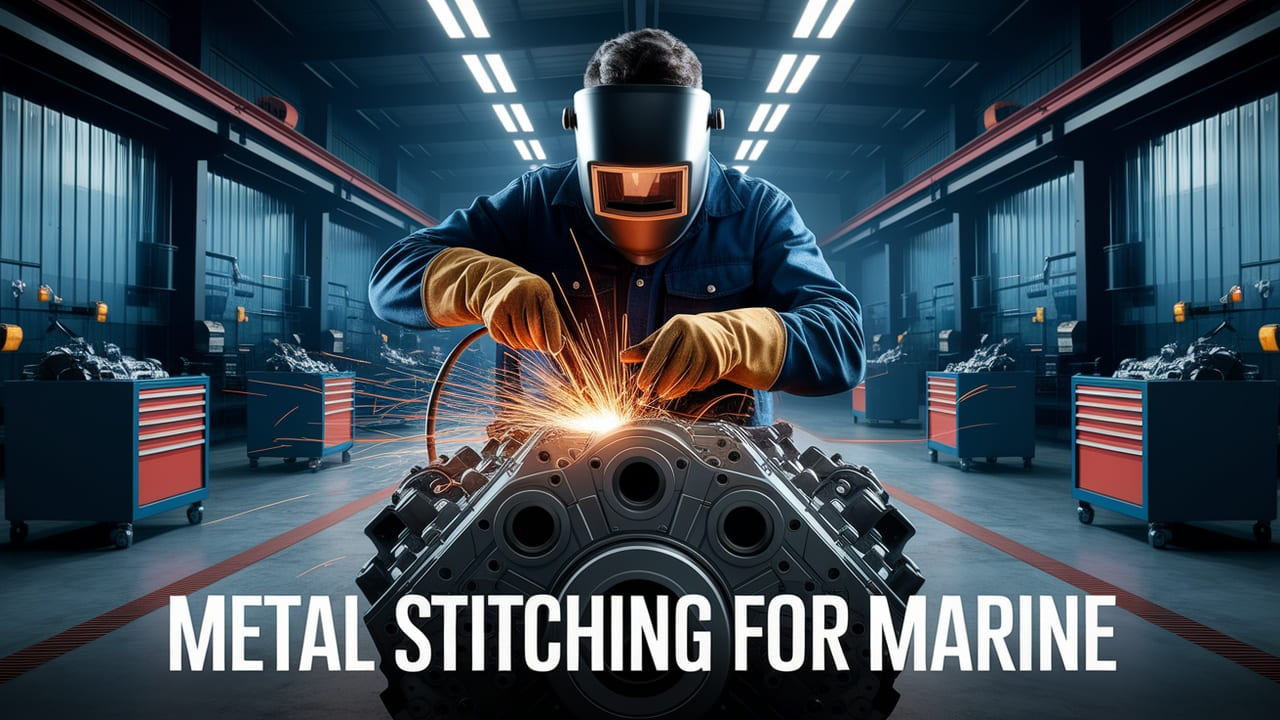Introduction
Engines are significant in marine and industrial settings as they help ships, machines, and factories work properly. If an engine gets damaged, it can stop working, which can lead to financial losses and delays. Hence, keeping good condition of engines and regular maintenance is necessary to avoid expensive breakdowns and to ensure smooth operation.
Engine parts that have cracks or other damage may cause major issues. Because of these small cracks expanding it can cause the engine to fail. Changing or repairing these components can be costly and time-consuming. Any stoppage can be very expensive in industries where engines run continuously.
Metal stitching is one of the reliable and reasonably priced ways to fix damaged engine parts. The repair procedure for precision metal stitching is cold, which further prevents the damage as there is no heat involved in the process. This technique helps the engine last longer by restoring the metal’s strength.
What is Metal Stitching?
Metal stitching is a technique to fix the broken or cracked metal components without welding. It joins the broken pieces together by putting metal locks and pins into the crack.
The damaged part becomes strong again through this process. Since metal stitching doesn’t involve heat it’s preferable rather than welding. Heat stress from welding can weaken the metal and lead to additional cracks.
Metal stitching stops distortion and preserves the part’s original strength. Preventing thermal damage, saving money and preserving structural integrity are some advantages of metal stitching. It is a dependable method for repairing metal parts like engine blocks.
Importance of Metal Stitching for Marine and Industrial Engines

In industrial and marine environments, engines operate in challenging circumstances. Damage and cracks appear over time, which may result in expensive malfunctions. Marine Engine Repair can restore marine engine parts using metal stitching, an efficient repair technique without requiring extensive disassembly or complete replacement.
Marine Engines:
Marine engines operate constantly in challenging conditions, including high temperatures, exposure to saltwater, and heavy loads, because of which engine blocks and other parts crack.
Large engine parts can be repaired with metal stitching, which is strong and long-lasting. It lowers downtime, stops additional damage and saves money. Marine engine repair using metal stitching ensures quick, reliable repairs without disassembling the entire engine.
Metal stitching doesn’t use heat, and it prevents thermal distortion, because of which engine strength is preserved. It keeps the ships running, reducing the maintenance costs and delays. Precision Metal Stitching ensures the dependability and durability of their engines.
Industrial Engines:
Power plants, mines and factories are powered by Industrial Engine Repair that operate for extended periods while carrying heavy loads.
Engine blocks and other parts are costly and time-consuming to replace. Repairing damaged engine parts without removing them is possible with metal stitching, which is both sturdy and economical.
By using the metal stitching technique, additional damage and expenses can be avoided, and the engine remains strong. Industries benefit from metal stitching by avoiding replacements and extending the lifespan of machines.
Key Benefits of Metal Stitching Services
- Metal stitching is less expensive than welding or replacing engine parts. It reduces the cost of repairs.
- Comparing it to welding, metal stitching doesn’t require heat. By not using heat to do this, the metal remains strong and stops additional cracks.
- Metal stitching repairs last a long time by restoring the part’s original strength and hence, it is more durable and Long-Lasting.
- Industries can save time and prevent delays by using metal stitching method to repairs on-site without having to remove the engine.
- Metal stitching fixes broken parts rather than discarding them. This benefits the environment by lowering metal waste.
How the Metal Stitching Process Works

The operation of the Precision Metal Stitching process.
Step 1: Inspection and Damage Assessment.
To assess the damage and plan the repair, experts examine the cracked or broken area.
Step 2: The second step is to drill precisely along the crack.
To make room for metal keys or pins to be inserted, tiny holes are drilled along the crack.
Step 3: Stitching pins or metal keys are inserted.
To secure the broken components together sturdy metal keys or pins are inserted into the drilled holes.
Step 4: Sealing the Repair Area for Maximum Strength.
To restore the metal’s original strength the repaired area is tightly sealed.
Step 5: Performance and Structural Integrity Testing.
Before being used, the repaired part is tested to make sure it is sturdy and functions as intended.
Industries That Benefit from Metal Stitching Services
Marine Shipping and Offshore Vessels
Without welding, metal stitching is a technique for fixing cracks in metal components. This service saves time and money by fixing broken machinery, which benefits many industries.
Marine Engine Repair is one of the key applications where metal stitching is used. Repairing engine blocks, pumps and other metal components on ships and offshore platforms is done by the maritime and shipping sector using metal stitching. This keeps ships in good operating order and avoids expensive delays.
Power Plants and Industrial Factories
Factories and power plants depend on massive machinery that needs to run constantly. Industrial Engine Repair using metal stitching can be used to repair a turbine or generator crack without temporarily stopping the entire system.
Mining and Heavy Machinery
Crushers and excavators are examples of heavy machinery and mining equipment that are subject to significant wear and tear. By repairing damaged components, metal stitching increases their longevity and decreases downtime.
Automotive and Locomotive Engines
Metal stitching is advantageous to the locomotive and automotive industries as well. In cars and trains, metal parts like cylinder heads, engine blocks and other parts can be fixed rather than replaced. Resilient, leak-proof equipment is essential to the oil and gas industry.
Oil & Gas Industry Equipment
Metal stitching ensures efficiency and safety by repairing cracks in drilling equipment, pumps, and pipelines. All things considered, Metal Stitching Services is an affordable and dependable method of repairing important metal components in a variety of industries.
How to Choose a Reliable Metal Stitching Service Provider
Choosing the right service provider for metal stitching is important to ensure the long-lasting repairs and smooth functioning of the machine.
- Focus on their experience and expertise
It is important to give top priority to a metal stitching service provider’s knowledge and experience in fixing industrial and marine engines. Due to their specific needs, these engines require specialized knowledge to ensure reliable and long-lasting repairs. Experts in this field can effectively manage complicated problems and provide solutions that are customized to meet your unique requirements.
- Using precise techniques and superior materials
The quality of the materials used determines how long-lasting and successful metal stitching is. Using premium alloys and tools that can survive challenging industrial or marine conditions is a sign of a trustworthy service provider.
By ensuring that the repair is strong and long-lasting precision techniques reduce the likelihood of further failures. Always make sure the materials and procedures used adhere to industry standards by asking about them.
- On-site repair services
Repairs at the operational site might be required in certain circumstances. Make sure the provider can provide on-site services, particularly if it is not feasible to transport large machinery. On-site repairs can prevent additional shipping expenses and drastically cut downtime.
- Case studies, testimonials and reviews
Always read through client testimonials, case studies and reviews before choosing a provider. The dependability level of service quality and general customer satisfaction of the provider are all revealed by these. You can feel more secure about your decision if you have heard good things from previous customers.
Why Metal Stitching is the Future of Engine Repairs

- The growing need for non-invasive and sustainable repair methods.
Metal stitching is becoming a more popular non-invasive and environmentally friendly engine repair method as industries place a greater emphasis on sustainability.
Metal stitching fixes the current parts, minimizing waste and the need for new materials in contrast to conventional techniques that might call for replacing entire engine parts.
- Superior Metal Stitching Methods that Increase Repair Dependability.
Repairs are now more durable and dependable thanks to new Metal Stitching Services. These techniques guarantee that broken or cracked engine parts can function like new by precisely and firmly bonding them.
This accuracy extends the engine’s lifespan and boosts its overall performance by lowering the likelihood of additional damage. Saves money and time when compared to replacing the entire engine.
- Cost-effectiveness is one of metal stitching’s main benefits.
Metal stitching fixes the damage fast and for a much lower price than replacing costly engine parts.
Additionally, this approach saves time because repairs can be finished more quickly than a complete replacement, reducing business downtime and maintaining engine performance.
Conclusion
For the repair of industrial and marine engines, Metal Stitching Services is a dependable, economical and efficient technique. It has many advantages, including lowering downtime, avoiding heat damage and prolonging engine component life.
By employing sophisticated methods, it repairs damaged parts without requiring costly replacements. The future of engine repairs for companies that depend on constant engine performance is metal stitching.
To keep your engines operating smoothly and prevent expensive interruptions, think about selecting metal stitching services if you’re searching for a durable, reasonably priced fix. Speak with a reliable supplier right now!
Focus keywords: Metal Stitching Services -7
Other keywords: Marine Engine Repair, Industrial Engine Repair, Precision Metal Stitching -3











No Comments